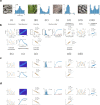This is a preprint.
A power law of cortical adaptation
- PMID: 37292876
- PMCID: PMC10245856
- DOI: 10.1101/2023.05.22.541834
A power law of cortical adaptation
Update in
-
A power law describes the magnitude of adaptation in neural populations of primary visual cortex.Nat Commun. 2023 Dec 15;14(1):8366. doi: 10.1038/s41467-023-43572-w. Nat Commun. 2023. PMID: 38102113 Free PMC article.
Abstract
How do neural populations adapt to the time-varying statistics of sensory input? To investigate, we measured the activity of neurons in primary visual cortex adapted to different environments, each associated with a distinct probability distribution over a stimulus set. Within each environment, a stimulus sequence was generated by independently sampling form its distribution. We find that two properties of adaptation capture how the population responses to a given stimulus, viewed as vectors, are linked across environments. First, the ratio between the response magnitudes is a power law of the ratio between the stimulus probabilities. Second, the response directions are largely invariant. These rules can be used to predict how cortical populations adapt to novel, sensory environments. Finally, we show how the power law enables the cortex to preferentially signal unexpected stimuli and to adjust the metabolic cost of its sensory representation to the entropy of the environment.
Figures







References
Publication types
Grants and funding
LinkOut - more resources
Full Text Sources
